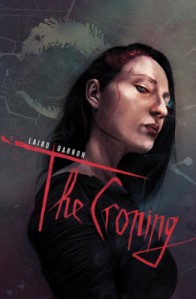Folklore shows its dark side with an interesting blend of fantasy and horror in Thale (pronounced “tall-ay”). The plot centers on two unsuspecting crime scene clean-up men who get more than they bargained for when called to the scene of a days old incident at a remote farm. At the crime scene, our heroes, Elvis (Erland Nervold) and Leo (John Sigve Skard), discover a naked, shivering girl, Thale, who doesn’t appear to be able to communicate. Through several recordings on cassette tapes left by the old man who cared for her and a series of flashback memories transmitted by touch, we learn Thale’s history. Soon, it becomes clear that Thale is not the only surprising encounter that our heroes will have, and while they try to protect this clearly fearful girl, they slowly come to realize that she herself may actually be something to be feared.
Thale is based on a creature from Scandinavian folklore called a “huldra”. These creatures were said to appear as beautiful women from the front, but from behind their bodies were hollowed out like a rotten tree trunk. The creatures also had a tail — either that of a fox or a cow — and many images and tales integrate the identification of these woman in some way with the appearance of this tail. Information on whether these creatures were to be feared is sketchy. Some tales say that men took them as wives, but others say that the huldra took men off into the forest and killed them. It seems, that like any fey creature, their intents and actions were unpredictable at best.
I’m a sucker for good foreign fantasy, and I liked this movie because it was interesting and different from standard fare. There is a not really a lot of blood and gore in the movie (most of it is during crime scene cleanup), and it focuses more on the frightening aspect of the unknown. The woods hold additional secret creatures that play a part in the film, and there are some very well crafted creepy scenes. The mystery of where Thale comes from is handled in an interesting way. I was left wanting even further explanation, but that lack also leaves room for further speculation and consideration of the story. Many foreign films don’t feel the need to tie up all the loose ends for viewers, and I often enjoy this over the American way of tying up everything with a bow.
Thale doesn’t speak, and most of her communication is done via facial expression and movement. I think this would be pretty hard to pull off as an actor, but Silje Reinåmo does a great job. Interaction between Elvis and Leo creates an interesting realistic background off of which to play the fantasy elements. Their conversations are the typical minimalistic exchanges that make up so much of everyday life, and their reactions when faced with the situation at the farm ring true in a humorous way. This blending of humor and horror is tricky, but Thale does a pretty good job, and it kept me interested until the end. Thale is available for rental download or purchase at Amazon.





